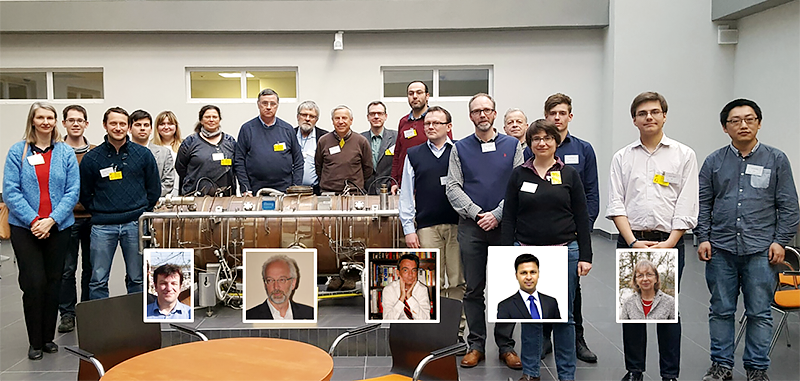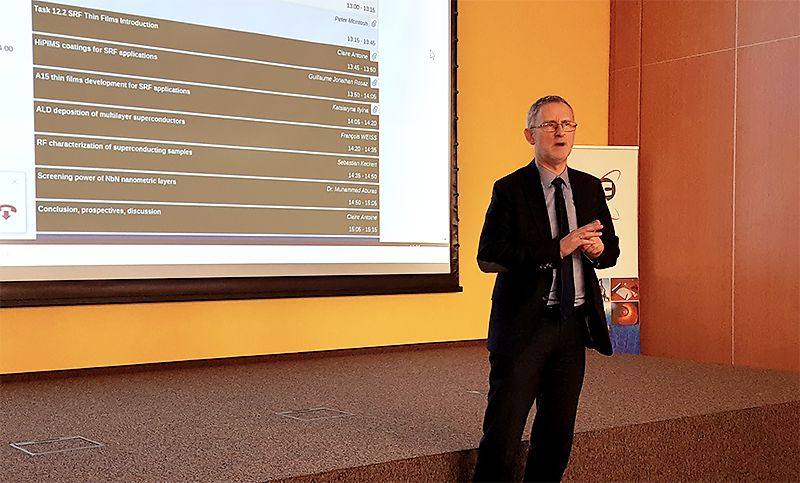![]() Fourth meeting on innovative RF technologies
Fourth meeting on innovative RF technologies
by Peter McIntosh (STFC)

Participants of the EuCARD-2 WP12 gathered at NCBJ in Warsaw, Poland (Image: Peter McIntosh)
As EuCARD-2 came to the end of its four-year duration, the Work Package 12 (WP12) Innovative Radiofrequency (RF) Technologies activity held its fourth and final group meeting at the National Centre for Nuclear Research (NCBJ) in Warsaw, Poland in March 2017.
The group organised previous Annual Meetings at CEA Saclay in France, DESY in Germany, and the STFC Daresbury Laboratory in the United Kingdom. The events aimed to provide specific updates on its areas of activity, which included: Superconducting RF Thin Films, High Gradient Normal Conducting Technologies, Superconducting RF Higher Order Mode Diagnostics, and RF Photocathodes.
The 2017 meeting drew 23 participants from 11 of the 13 collaborating organisations, encompassing representation from the UK, France, Germany, Poland and Sweden. In terms of the diversity balance of the attendees, five (22%) attendees were women and three (13%) were from ethnic minority groups.
It was coordinated by Peter McIntosh (STFC Daresbury Laboratory), who has led the 5M€ WP12 delivery programme since its inception in 2013. The meeting itself was organised by Robert Nietubyć (NCBJ) who provided all of the local logistics.

Professor Krzysztof Kurek addresses participants of the EUCARD-2 WP12 2017 Annual Meeting
(Image: Peter McIntosh)
The event kicked off with an opening address and welcome from the NCBJ Director, Professor Krzysztof Kurek, who placed the capabilities of NCBJ firmly in the context of Innovative RF and accelerator technologies. Peter McIntosh then gave a management overview for the WP12 project as the EuCARD-2 programme comes to an end, before each of the WP12 task leaders presented their respective activity areas.
In the activity focused on SRF Thin films, the first high temperature SRF thin film deposition using Nb3Sn was realised at CERN. In addition, the highest Tc ever reached achieved 17.06K using CVD deposition of NbN by INP Grenoble. A new high precision magnetometry system for larger RF samples was validated at CEA Saclay.
For High Gradient Normal Conducting Technologies, University of Manchester developed an optimised X-band Damped Detuned Structure for the 380 GeV CLIC facility, whilst the first high efficiency ‘Kladistron’ developed by CEA Saclay began fabrication with Thales. Lancaster University also contributed in the development of a new high precision RF distribution system, able to provide ultra-precise timing synchronisation for a pair of CLIC X-band crab cavities.
Regarding the SRF HOM Diagnostics task, the Universities of Rostock and Manchester reported on the optimisation of simulation tools able to model very long linac structures using concatenated analysis and generalised scattering matrix techniques. In addition, the electronics needed to monitor cavity HOM signals have been prototyped and tested on FLASH, and have been implemented on XFEL by DESY.
For the RF Photocathodes activity, STFC has installed a new High Repetition Rate RF gun and cathode exchange system at the CLARA FEL test facility at Daresbury Laboratory. In addition, NCBJ has made optimised lead photocathode surfaces, and their operation was validated by DESY. Furthermore, the performance of magnesium photocathodes was demonstrated at HZDR-Rossendorf.
The local NCBJ organiser also invited the participants to visit the Warsaw Neon Muzeum as well as to tour the NCBJ facilities, including radiotherapy systems developed by NCBJ specialists and provided to commercial organisations.
In the summary of the final WP12 meeting, Peter McIntosh stated that he was tremendously impressed by the depth and breadth of work undertaken over the past four years by the collaborating institutes. The objectives of WP12 to break new ground on RF technologies were certainly ambitious when set-out back in 2013, yet in many areas the teams involved succeeded, laying the groundwork for a long-standing legacy for the international RF and accelerator communities for years to come.
The 2017 EuCARD-2 WP12 Annual Meeting was covered in live time via the ASTeC Twitter account.
